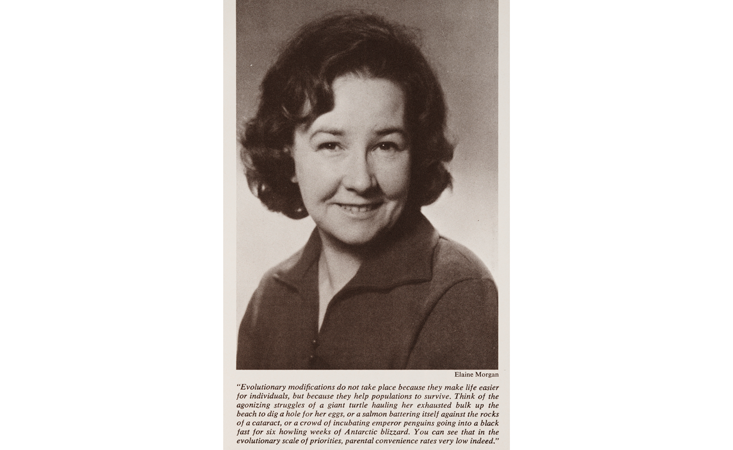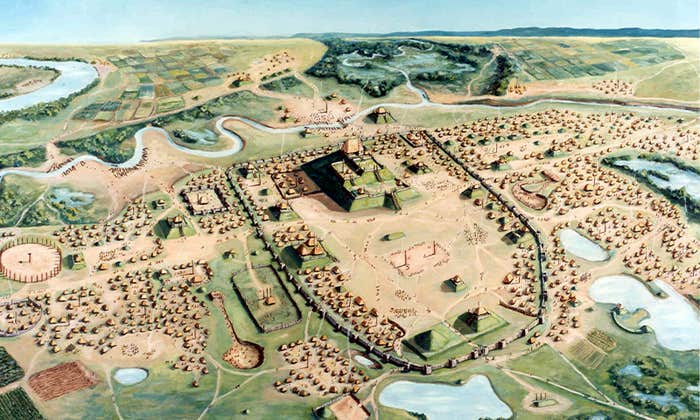Elaine Morgan had sass. In Descent of Woman, published in 1972, she asked her readers to take science into their own hands. “Try a bit of fieldwork,” she suggested. “Go out of your front door and try to spot some live specimens of Homo sapiens in his natural habitat. It shouldn’t be difficult because the species is protected by law and in no immediate danger of extinction.” After completing observations of 20 random people, she suggested, substitute them when you are reading statements about universal human nature. The result?
“That window cleaner is one of the most sophisticated predators the world has ever seen.”
“The weapon is my grocer’s principal [sic] means of expression, and his only means of resolving differences.”
“The postman’s aggressive drive has acquired a paranoid potential because his young remain dependent for a prolonged period.”
Morgan added that you might imagine you were observing the wrong species and urged her readers to trust their experiences. “Remember,” she wrote, “you have been living among thousands of these large carnivores all your life, on more intimate terms than those on which Jane Goodall lived among the chimpanzees.”
In positing such a scenario, Morgan was engaged in serious work. All popular theories of human evolution to date, she insisted, were based on a male-centered notion of human evolution. Where were the evolutionary scenarios that began, “When the first ancestor of the human race descended from the trees, she had not yet developed the mighty brain that was to distinguish her so sharply from all the other species…”? This formed one of two major points Morgan wished to make in Descent of Woman.

The second was to advance a theory of aquatic adaptation that preceded life on the savannah. In semi-adaptation to a watery world, she imagined, humanity’s ancestors may have lost their body hair, gained a layer of subcutaneous fat to keep them warm, learned to walk upright (keeping their heads above water while foraging for tasty snacks in the shallows), came to use stones and manufacture tools for breaking open shells, and developed the ability to control their breathing when diving beneath the surface—a precondition for true spoken language and an obvious boon to any individual trying to communicate with most of her body submerged.
In short, Morgan suggested humans acquired precisely those traits that distinguish them from the rest of the animal world while living around water, not in the arid grasslands. These activities, she noted, were associated with gathering, not hunting, an activity in which women’s contributions were widely acknowledged.
Morgan’s story tells us as much about the gendering of evolutionary theory during the Cold War as it does about the history of scientific debates that take place in the public eye. She submitted her manuscript to Souvenir Press with the title The Evolution of Eve. Just before publication, she changed it to Descent of Woman. “Woman,” she reasoned, was a commercially appealing word in the late 1960s and she worried too that “Eve” would sound old-fashioned and Biblical to the younger, female readers she hoped to attract. Her publisher was persuaded because the title echoed Charles Darwin’s Descent of Man, which in 1971 was enjoying a centennial moment, as it is again in 2021. Setting aside questions of feminism, Morgan’s critics decried her work for its lack of concrete evidence. In this way, the popularity of evolutionary books served to amplify the political import of the theories they contained. These books also constituted a foil for professional scientists seeking to forge their own scientific standing.
Descent of Woman fit well into a genre of colloquial science that aimed to present scientific arguments to readers with common sense but little scientific training. Such books provided scientific authors with a venue for rendering their ideas in a more conversational tone than they would be allowed in standard academic venues and provided non-scientifically trained authors, like Morgan, with opportunities to contribute to public debates over scientific ideas. By relying on arguments and evidence intelligible to nonscientific audiences, these books sold well. They were also left open to marginalization by the scientific community.
Morgan was Oxford-educated (in English), the mother of three children, lived in Wales, and had been writing screenplays and dramas for the BBC for decades. When she turned her attention to nonfiction, it was out of irritation with the evolutionary books of the time that emphasized the contributions of men. The aggressive masculinity they advanced left little room for women and, in stark opposition to these volumes, Morgan was read as a radical feminist with a sense of humor.
Morgan derided male-centered theories of human evolution as “Tarzanist.”
When Robert Ardrey published his bestselling African Genesis in 1961, it was merely the first in a series of books depicting man as an aggressive hunter. Ardrey, an early advocate of paleoanthropologist Raymond Dart’s “killer ape” theory, suggested that “even in the first long days of our beginnings we held in our hand the weapon, an instrument somewhat older than ourselves.” Weapons preceded humanity, weapons fathered humanity. (Just think of the “Dawn of Man” sequence in 2001: A Space Odyssey.) In his next nonfiction foray—The Territorial Imperative—it became clear that by mankind Ardrey really had meant men, and the violence with which he was preoccupied was associated with male members of a group defending their common territory against outsiders. Evolutionary pressures on groups of men, intent on hunting to support the women and children safe in camp and cooperating to defend their home from hostile incursions, drove the increased intelligence that came to characterize all humanity.
Zoologist Desmond Morris, on the other hand, was initially more preoccupied with sex than violence or male-male bonding. In the first paragraph of the introduction to The Naked Ape, Morris suggested that Homo sapiens “is proud that he has the biggest brain of all the primates, but attempts to conceal the fact that he also has the biggest penis.” In contrast to Ardrey, he emphasized the development of a pair bond between adult males and females. The pair bond ensured that females remained faithful to their individual males when hunting duties called males away from camp; it reduced serious sexual rivalries between males which aided in the development of male cooperation; and the young benefited from a cohesive family unit. Such a process, he was careful to add, “was never really perfected,” but was a crucial component of his new ecological role as a “lethal carnivore.”
Morgan had first come across the idea of an aquatic phase in humanity’s deep history while reading a scant two pages that Morris devoted to the concept. She contacted the theory’s originator—Sir Alistair Hardy—and asked whether he would mind if she worked on a book responding to the contemporary theories of human evolution and developing his suggestion. Like Ardrey, she may have believed that artists and writers were well-developed students of human nature, despite their lack of anthropological training. Hardy, who had conceptualized the aquatic theory 30 years earlier, initially refused to publish anything on it lest he ruin his nascent academic career. At the time, he had plenty of experience at sea and in marine biology, but lacked a permanent post. In 1960, as a recently knighted and well-established professor of zoology at Oxford, he agreed to write a brief article in The New Scientist proposing an aquatic past for humanity. It was to be Hardy’s only publication on the topic, and he was more than happy to let Morgan run with it.
Morgan derided male-centered theories of human evolution as “Tarzanist,” and her frustration with them is palpable when reading Descent of Woman. The scientific facts used to buttress their arguments were unassailable, she insisted, but not the interpretations of those facts. She further noted that the term “man” was ambiguous, denoting both the entire species and also the males of the species. The trick was not to confuse the two. Adding carefully that although this might sound like “a piece of feminist petulance” to some, Morgan hoped to convince her readers that her semantic point vitiated much of the “speculation” concerning the evolutionary origins of humanity.
Women had been ignored by the “blood-and-thunder boys.”
Further, Morgan contended that based on the available evidence it was impossible to distinguish weapons from tools and impossible to know which sex invented them. “A knife is a weapon or a tool according to whether you use it for disemboweling your enemy or for chopping parsley.” In fact, she reasoned, it was likely that early humans used tools for both purposes—the strict dichotomy between herbivores and carnivores in our past was never clean-cut.
Why, then, were such assumptions about the importance of men to the evolutionary progress of humanity so widespread? Morgan chalked this up to a combination of male pride and egotism. She extensively quoted Ardrey’s Territorial Imperative in order to rebut his characterization of men as baboon-like. A male baboon, he had written, “is born a bully, a born criminal, a born candidate for the hangman’s noose. He is as submissive as a truck, as inoffensive as a bulldozer, as gentle as a power-driven lawnmower. He has predator inclinations and enjoys nothing better than killing and devouring the newborn fawns of the delicate gazelle.”
Morgan imagined that a male reader would naturally find this characterization appealing. She pictured him polishing his glasses, thinking: “Yeah, that’s me all right. Tell me more about the bulldozer and how I ravaged that delicate gazelle.” The reason such theories continued to be popular was because Ardrey’s typical reader, like the author, enjoyed the idea of “all that power and passion and brutal virility … seething within him, just below the skin, only barely held in leash by the conscious control of his intellect.”
It was high time, she thought, to expose these arguments for what they really were—myths, yes, but politically useful myths. Morgan argued that man-the-hunter theories were used to “bolster up with pseudo-history and pseudo-anthropology the belief that it is ‘against nature’ for women to play a part in economic life.” Based on evidence from modern hunter-gatherer societies, she noted that the bulk of the total diet of early humans was probably the result of gathering vegetable matter, not hunting meat. Women were important to the evolutionary history of humanity, but had been ignored by the “blood-and-thunder boys.”
Reviews of Descent of Woman picked up on Morgan’s none-too-subtle revisionist agenda. Playboy hailed it as a “stunning tour de force,” speculating that, “even the most militant male chauvinist will find it difficult to cling to all his prior convictions in the face of the evidence marshaled here.” Similarly, Life magazine described Descent of Woman as a lively “women’s-lib prehistory.” Several reviewers missed that Morgan didn’t have any anthropological training, describing her as “a female anthropologist,” and “a scholarly woman, educated at Oxford in the fields of paleontology, ethology, and anthropology.” Yet even when people recognized her outsider status, they still acknowledged the force of her arguments against the then-standard evolutionary history of humanity. Her reviewer in The New York Times, for example, characterized Descent of Woman as “a potent commentary on the state of the social sciences in general, and anthropology in particular.”
By the late 1970s, even scientists cited Morgan’s Descent of Woman as an early critique of “man the hunter” theories of human evolution. Yet although Morgan’s critique was useful, it came packaged along with her interest in Hardy’s aquatic ape. Physical anthropologist Adrienne Zihlman lamented that Morgan’s sensible and “substantial critique of existing evolutionary dogma did not get the attention and credibility it deserved,” because it had been “contaminated by Morgan’s own elaboration and support of a very dubious theory of human origins, the ‘Aquatic Ape’ hypothesis.” Zihlman regretted the visibility of Morgan’s writings because she feared readers might get the mistaken impression Descent of Woman was the best feminist anthropology could offer.
“Tell me more about the bulldozer and how I ravaged that delicate gazelle.”
Morgan was aware that her interest in the aquatic ape might be perceived as outside the normal bounds of science. In a 1973 interview she remarked that perhaps it was easier for her to develop these ideas than for an established scientist (one can only assume she meant Hardy), because she had “nothing to lose, no high academic position to think of.” She added, “if you talk about flying saucers you’re branded a kook. I don’t believe in flying saucers but I suppose this kind of thing looks flying-saucerish to the Establishment.”
In fact, this was exactly what “Establishment” science thought. Her reviewer in The New York Times, for example (although he had lauded her critique of contemporary anthropology), suggested that her characterization of human ancestors as including “a breed of sea beasts” should be consumed along “with a grain or two of salt.” Several years later, Zihlman, together with physician Jerold Lowenstein, wrote a brief article for Oceans magazine in which they compared the “Aquatic Ape Theory” to “the existence of bigfoot” and “visitors from outer space.” After analyzing key aspects of the evidence, they concluded, “the Aquatic Ape Theory does not hold water, anatomically, biochemically, behaviorally or archaeologically. With a similar combination of imagination, a grab bag of unrelated ‘facts’ and a popular literary style, one could make an equally convincing case that our ancestors evolved in the air—as von Daniken has more or less done in his cult book Chariots of the Gods?”
Despite this dismissal, and with some urging from an American fan, Morgan wrote a second book, The Aquatic Ape, in 1982, in which she re-presented her evidence in more scientific terms. This time, she included figures illustrating her points and, notably, her prose no longer contained the feminist critique which had been so well received in her first book. Scientists remained skeptical. One reviewer noted, “Until some hard evidence is found, though, I fear we are left with several equally convincing theories floating in a sea of speculation.” Lowenstein, too, remained unconvinced, remarking, “It is fun to make up evolutionary fables.” Unfazed by such criticisms, Morgan published The Scars of Evolution in 1990 and The Descent of the Child five years later, each updating her evidence to reflect more recent findings. And although most scientists continued to dismiss her ideas as speculative or pseudoscientific, a small number became intrigued.
Morgan’s critics used the aquatic ape theory to delegitimize feminist science.
The first sign of interest came in the form of a 1987 conference organized to debate the theory, which included both advocates and detractors. Most of the supporters, however, lacked anthropological training, including, for example, Derek Ellis, a marine ecologist from the University of Victoria in Canada, and Marc Verhaegen, a Belgian physician. Ellis argued that the aquatic ape was ecologically viable and called for scientists to test the theory, rather than dismissing it out of hand. (Anthropologists, of course, felt it had been evaluated.) Verhaegen, along with a handful of other scientists, began to amass new kinds of evidentiary support for an aquatic phase in human history. They argued that chimpanzees and bonobos were known to walk upright while wading in shallow water and when carrying objects in their arms, that recent paleontological evidence suggested that early hominins spent more time in swampy or coastal forests than on the savannah, and that foods high in fatty acids (like fish) could have been important to the increased brain development in our ancestors.
Anthropologists, with a few notable exceptions, have been far more reticent. The first convert was Philip Tobias, former student of Raymond Dart. Like Ellis, he came to insist that the aquatic ape needed a fair hearing. More recently, well-respected professors Richard Wrangham (biological anthropologist), Dorothy Cheney (primatologist), and Robert Seyfarth (psychologist) published a paper in which they suggested that early human ancestors used aquatic environments to forage for fallback foods, like water lilies and floodplain herbs, when their preferred foods were unavailable, and the aquatic environment in which these foods are found could have helped human ancestors become bipedal.1
There are several important points to note about this history of the aquatic ape. The theory itself remains controversial; all of these claims have been challenged in the scientific literature.2 Additionally, none of the recent papers supporting an aquatic (or semi-aquatic) environment for human ancestors mention or cite Morgan or Hardy by name—to find the connection, you must look in the footnotes of the papers they do cite. Scientific theories can thus become separated from their most ardent supporters, even (perhaps especially) in cases where the equation is almost iconic.
Historians of science have spilled much ink on the demarcation question, asking how scientists and philosophers have tried to cleanly differentiate legitimate scientific inquiry from “non-science,” “pseudoscience,” “pathological” science, or even simply “bad” science. In considering Morgan’s case, we can see that in addition to these hard demarcations, scientists in the 1970s also used feminist science as a tool of soft demarcation. By labeling Morgan’s Descent of Woman “feminist anthropology” they sidestepped her critique and used the aquatic ape to delegitimize feminist science as a whole—precisely the reason Zihlman attacked the book as pseudoscientific. Emulating the efforts of many fringe scientists, Morgan responded by re-articulating her argument and her evidence with each new publication, in an attempt to rehabilitate her claims by presenting them in a style and language scientists would take seriously.
In order for Morgan’s ideas to be considered plausible, they had to be stripped of her sharp feminist wit, dissociated from Morgan herself, and repackaged as legitimate science. In this form, her ideas are now getting the professional hearing she always wanted. In 2005, Morgan was asked whether she still felt like an “outsider” in biology. “Not nearly as much as I used to,” she replied.
Erika Lorraine Milam is a professor of history at Princeton University. Her award-winning Creatures of Cain: The Hunt for Human Nature in Cold War America was published by Princeton University Press in 2019.
This essay is adapted from “Dunking the Tarzanists: Elaine Morgan and the Aquatic Ape Theory.” Reprinted with permission from Outsider Scientists: Routes to Innovation in Biology edited by Oren Harman and Michael R. Dietrich, published by The University of Chicago Press. Featured text by Erika Lorraine Milam. © 2013 by The University of Chicago. All rights reserved.
Footnotes
1. Wrangham, R. The delta hypothesis: Hominoid ecology and hominin origins. In Lieberman, D.E., Smith, R.J., & Kelley, J. (Eds.) Interpreting the Past: Essays on Human, Primate and Mammal Evolution in Honor of David Pilbeam Brill Academic, Boston, MA (2005); Wrangham, R., Cheney, D., Seyfarth, R., & Sarmiento, E. Shallow-water habitats as sources of fallback foods for hominins. American Journal of Physical Anthropology 149, 630–642 (2009).
2. Debates over the aquatic ape are also alive and well on the Internet. See, for example, www.riverapes.com (pro) and www.aquaticape.org (con).


























